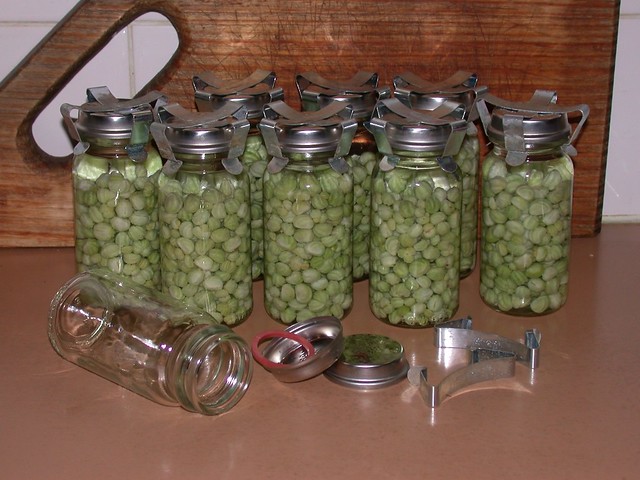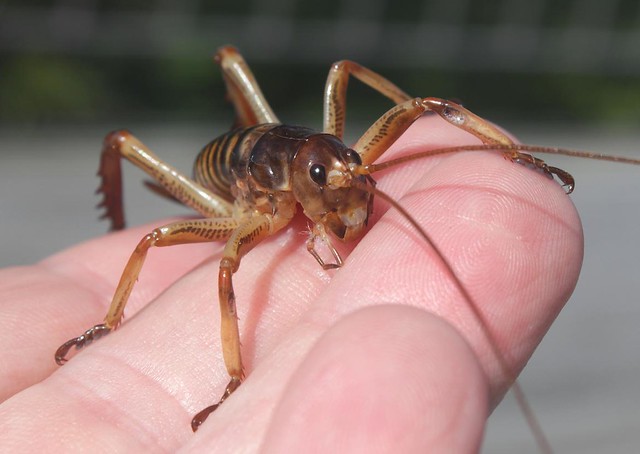Who found it was just as I feared:
While barrowing wood
For next winter’s good
Found a weta (med-small) in his beard.
To my great surprise, he did not yell, scream, give himself an emergency beard-ectomy, or burn the house down. Truly a deep and mysterious man, the Caped Gooseberry.
Unlike last year, we managed to finish stacking the year’s firewood in one day, despite the heat (27C/81F) . Four cubic metres – approx 141 cubic feet, for the imperialists – barrowed by the aforementioned Caped Gooseberry, and stacked by yours truly. That was Tuesday, and I have just about recovered.
The other great endeavour of the garden just lately has been the pickling of nasturtium seeds. Apparently you can eat the leaves and flowers as well – though the prevalence of a) ants and b) bees puts me off the latter – but if you pickle the seeds they are said to taste like capers.
In the spirit of scientific enquiry, I tried a pre-pickled seed. The taste, and, indeed, the zing, was rather reminiscent of a radish. A very very small radish, obviously: we are not growing giant mutant nasturtiums in our back garden. (Yet.)
Here’s how I did it. I picked all the seeds that looked of reasonable size but hadn’t got sort of hardened yet. After picking off sundry bits of stem, bugs etc I measured them and they came to pretty much a cupful.
Following the instructions I found here, I brought two cups of water and four tablespoonfuls of salt to the boil in a small pot, and then poured the hot brine over the cupful of seeds, now resident in a soup bowl. This I then covered with a tea towel and left for three days.

Once the vinegar was duly hotted up, I poured it over the nasturtiums and left to cool before lidding. It seems to me to make more sense to bung the lid on at once, causing a vacuum as the liquid cools, and avoiding the entrance of bugs, but Mine Not To Reason Why. In any case, only having one jarful meant that the air at large would in any case be admitted as soon as we needed to sample the goods.
Which, giving them a week to brood, I did. They’re quite tasty: less like a micro radish and more like a hard caper than previous to pickling. I was slightly disturbed by the dark dusty-looking stuff gathering on them till I realized it was the balsamic vinegar settling.

My only problem now is what to call them. “Pickled nasturtium seeds” takes too long, as does “poor man’s capers”. “Pickled tropaeolum majus seeds” is even worse. Just calling them capers would invite confusion with the actual capers next to them in the fridge. Suggestions?
Incidentally, have you ever heard of Elisabeth von Linné? She was the daughter of Karl von Linné, better known as Carl Linnaeus, and at the tender age of 19 she published a paper on the flashing of nasturtium flowers. Yes, apparently at dusk the orange flowers appear to let off sparks, and this is known as the Elizabeth Linnaeus Phenomenon. I have not observed it myself, but I shall keep a close eye upon them in future, and report back accordingly.



Lidding a still hot liquid before allowing to cool could very easily cause an inward pressure sufficient to crack the glass (or crumple a tin, if that is your sort of thing).
Also, wouldn’t slight overpressure be better than slight underpressure for ensuring things do not get in?
I haven’t had any trouble with lidding hot liquid marmalade. Possibly because I use the kind of jars where the lid has a clicky thing to suck inward. It’s traditional, inasmuch as metal lids with clicky things are traditional.
Slight overpressure is what we use for the cider. No, I lie. Massive overpressure is what we use for the cider 🙂 What would happen if we kept marmalade or pickly things at that pressure I don’t like to think. I’d have to clean the kitchen ceiling a lot more often, for one thing.
Perhaps the nasturtium contract more while cooling than marmalade does?
That’s a thought. They do look rather been-in-the-water-too-long wrinkly, but then they look pretty wrinkly even when they’re on the plant.